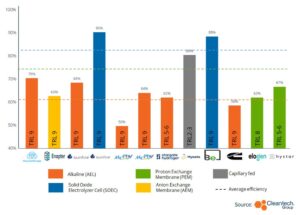Large Corporates Best Positioned to Drive the Price of Green Hydrogen to $1/kg Threshold, but Innovators May Win the Long Game
San Francisco, CA – September 5, 2023 — Green hydrogen may become competitive with so-called grey hydrogen within the next five years even without policy incentives, but innovation for long-term cost competitiveness in electrolyzers will come to bear only toward the end of the decade, according to a report from Cleantech Group.
Tax credits of up to $3/kg provided under the Inflation Reduction Act (IRA) will accelerate U.S. producers’ pursuit of the $1/kg mark ahead of schedule. Global market prices range between $5.76/kg in the UK and $2.19/kg in Sweden today.
“Incumbents like Cummins, Plug Power, and thyssenkrupp will dominate the electrolyzer market for at least the next five years, initially making the most progress towards the $1/kg price threshold, but innovators will disrupt the market toward the end of the decade with more efficient models that don’t rely on critical minerals,” said Sr. Associate Energy & Power, Selene Law.
Green hydrogen has many established and emerging end-use applications. Smaller-sized plants serve the mobility markets, and slightly bigger ones have emerged for transport hubs, including distance trucking, aviation, and maritime shipping. Industrial-scale units of up to 100MW capacity, capable of serving the steel, cement, and chemical industries, are set to roll into manufacturing as early as 2024.
Alkaline electrolysis (AEL) and proton exchange membrane (PEM) are the dominant, commercially mature technologies, but have long-standing challenges. Alkaline electrolyzers have slow ramp up and taper down times, making them difficult to pair with intermittent renewables. Proton exchange membrane electrolyzers have high efficiency and flexible ramping ability but are dependent on critical materials, especially platinum group metals.
“Emerging electrolyzer technologies, such as anion exchange membrane (AEM) or solid oxide, have been capturing the latest wave of investment in seed and Series A funding,” said Cleantech Group Analyst Alex Crutchfield. “They will likely challenge incumbents in the second half of the decade due to efficiency improvements and reduced dependency on rare metals.”
Electrolyzer System Efficiency (Lower Heating Value)

Key findings:
Drivers of real savings. Capital-cost reductions are being driven by new electrolyzer manufacturing capacity of 115GWs expected to come online by 2030, potentially raising total capacity to a maximum of 240GW. Simultaneously, higher PEM efficiencies being created by Chinese manufacturers will lead to lower operational costs, and closer price parity with alkaline.
March of innovation. In the first half of 2023, Bloom Energy installed the world’s largest solid oxide 4MW electrolyzer in a NASA research facility, while Enapter, maker of the first MW-class AEM electrolyzer, aims to bring a production facility online in 2024. Electric Hydrogen will start building 100MW electrolyzers at its gigafactory early in the same year, and Hysata’s capillary-fed alkaline electrolyzer with 80% LHV efficiency aims to produce 1GW worth of electrolyzers by 2025.
Robust policy initiatives. Besides subsidies written into the U.S. IRA, strong policy initiatives have emerged in the UK and Europe. The EU has created an accelerator program to help scale up hydrogen projects and outlined plans to create a Hydrogen Bank and auction subsidized green hydrogen. Meanwhile, the UK has set a 2025 goal of bringing online 1GW of electrolytic hydrogen production capacity in construction or operation and plans to make a decision on hydrogen use in heavy goods vehicles by 2024 and hydrogen heating by 2026.
About Cleantech Group
Cleantech® Group is the leading authority on global cleantech innovation. Since 2002, our research, consulting and events have catalyzed opportunities for sustainable growth powered by innovation. At every stage from initial strategy to final deals, we bring corporate change makers, investors, governments and stakeholders from across the ecosystem, the access and customized support they need to thrive in a more digitized, de-carbonized and resource-efficient future.